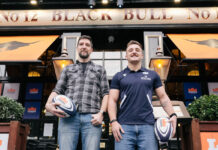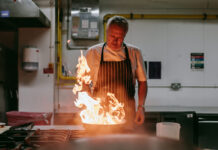Tennent’s master brewer is as passionate about beer as ever

By Dave Hunter
QUITE a lot has changed at the home of Scotland’s best-selling pint over the past four decades.
New owners and technology have left their mark on how Tennent Caledonian’s Wellpark brewery goes about its day-to-day business of brewing beer.
But as Bass Brewers gave way to Interbrew – later ABInbev –and then C&C Group, one of the constants at Wellpark has been the people, at least according to master brewer Keith Lugton.
Lugton, who celebrated his 40th anniversary with the brewery in September, joined the company as a trainee at 19 and has developed over 20 beers for the firm in addition to overseeing production of the flagship Tennent’s Lager.
“Throughout it all the people, the family structure, is still there,” he told SLTN.
“That’s been constant throughout.
“We’ve always felt it’s more like a family business than a corporate business.”
During his time at Wellpark, Keith has been involved in the launch of a variety of beers – including Tennent’s Velvet, Tennent’s Authentic Export and, more recently, the Caledonia Ales range.
In fact, with demand for new products so high, innovation now accounts for the lion’s share of his role.
To this end, he spends a fair bit of time at Wellpark’s younger, next door sibling, Drygate, using the smaller brewery’s brew kit to trial new beers.
“If I’m having to do a small-scale trial in the (Wellpark) brewery that’s 650,000 pints,” explained Keith.
“That’s a big trial.”
While some might be surprised by the level of experimentation that goes on at Scotland’s biggest brewery, Keith was keen to point out that the company is always keeping an eye on beer trends.
“Consumer trends do vary,” said Keith.
“They’re cyclical. You’ll get two or three years [of popularity] and then it’ll be something different.”
American-style beers, IPAs and continental lagers are among the beer styles Keith has witnessed gaining ground in recent years.
And, of course, there’s been the rise of craft beer.
It’s a market Tennent’s is active in – Drygate was established in 2014 as a joint venture between Tennent’s and craft brewer Williams Bros – and also one Keith has a lot of respect for.
“There are a lot more craft brewers now than there was 20 years ago, and I think that’s good,” said Keith.
“Anything that’s good for beer is good for the overall market, whether that’s breweries, publicans or consumers, because it’s bringing a bit of diversity, a bit of variety.”
Other trends have seen history repeat itself, such as the return of tank beer to the Scottish trade.
The system, which sees a pub serve beer directly from a large tank stored on the premises and is said to preserve the freshness of the beer better than kegs, has become trendy in Europe and London in recent years – and is now spreading into Scotland.
However, tank beer isn’t a recent innovation. In fact, Tennent’s was dispensing beer that way in the 1960s.
Keith said: “It was the perfect storm in some respects. The time was right for it. You had big-volume places – miners’ clubs, steelworkers’ clubs, and big city centre pubs where you had big volumes. And tank beer was ideal for that because it made life a lot easier for the publican, not having to change kegs all the time, and was easier in terms of deliveries.
“As tastes changed and imported beers became more requested in pubs, tank beer volumes started to decline and there came a point when it was uneconomical to maintain it.
“Because it’s happening on the continent it’s being brought back, but I like to remind people we did it first.”
The fall of on-trade beer volumes is one of the big trends Keith has seen during his time at Wellpark, but he is adamant that pubs are still key for Tennent’s.
And the changing face of the trade also has its plus points, said Keith.
“From what I see, there are a lot of new or reinvented pubs,” he said. “But then you’ve also got your traditional, authentic, die-hard pub that hasn’t really changed much. I think that’s something that has changed in the on-trade for the good – there’s more diversity in pubs. It’s offering more to the consumer than 20 or 30 years ago, when a pub was a pub.”



















